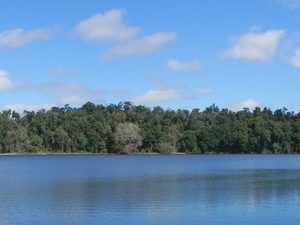Wednesday 17th of August 2011
Malanda—Lake Eacham | Lake Barrine | Yungaburra river walk—Malanda ...weiterlesen "Malanda – Lake Eacham – Lake Barrine – Yungaburra river walk"
Schlagwort: native forest
Category description
An old-growth forest (also termed primary forest, virgin forest, primeval forest, late seral forest, or in Britain, ancient woodland) is a forest that has attained great age (and associated structural features), and thereby exhibits unique ecological features. An old growth forest has also usually reached a climax community.
Old-growth forests tend to have more large trees and standing dead trees, multi-layered canopies with gaps resulting from the deaths of individual trees, and coarse woody debris on the forest floor.
Forest regenerated after a severe disruption, such as wildfire, insect infestations or harvesting, is often called second-growth or regeneration until enough time passes for the effects of the disturbance to be no longer evident. Depending on the forest, this may take anywhere from a century to several millennia. Hardwood forests of the eastern United States can develop old-growth characteristics in one or two generations of trees, or 150–500 years. In British Columbia, Canada, old growth is defined as 120 or 140 years of age in the interior of the province where fire is a frequent and natural occurrence. In British Columbia’s coastal rainforests, old growth is defined as trees more than 250 years, with some trees reaching more than 1,000 years of age.
Forest types have very different development patterns, natural disturbances and appearances. A Douglas-fir stand may grow for centuries without disturbance while an old-growth ponderosa pine forest requires frequent surface fires to reduce the shade-tolerant species and regenerate the canopy species.
In the boreal forest, catastrophic disturbances such as wildfire minimize opportunities for major accumulations of dead and downed woody material and other structural legacies associated with old growth conditions.
Many botanists specifically define old growth in terms of meeting several criteria, under which system forests with sufficient age and minimal disturbance are considered old growth. Typical characteristics of old-growth forest include presence of older trees, minimal signs of human disturbance, mixed-age stands, presence of canopy openings due to tree falls, pit-and-mound topography, down wood in various stages of decay, standing snags (dead trees), multi-layered canopies, intact soils, a healthy fungal ecosystem, and presence of indicator species.

